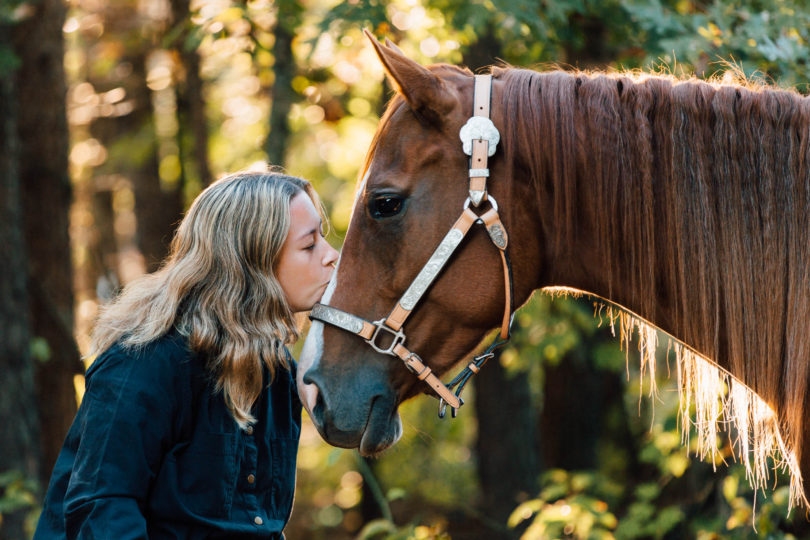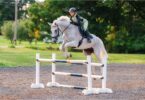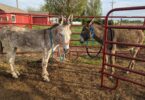How do you take great pictures of a horse? We’ll help you shoot like a pro.
For equestrians and non-equestrians, alike, horses are graceful and majestic creatures. Capturing all that beauty through photography seems like it’d be pretty straightforward. Just point and shoot with a fancy DSLR camera, right? Not exactly.
Becoming a skilled equine photographer (even if only for fun) takes practice, the right equipment, and a well-trained eye. The good news is that even horse rookies CAN do this. Read on to learn how!
What is Equine Photography?
Equine photography simply means pictures of horses!
There are many different types of imagery, so most photographers choose to specialize in one or two areas.
Some higher-level professionals pursue fine art equine photography and travel the world capturing images of some of the most exotic and beautiful horses on earth. Others prefer staying closer to home and capturing memories at local shows, senior photo shoots, or other events.
Depending on your skillset, equipment, and drive, you might be able to build a career. But even pursuing your equine photography as a part-time gig can be deeply rewarding.
Common Camera Terminology
- Aperture: This means the size of the opening in your lens and helps control how light or dark you images will be. Aperture is measured in “f-stops.” More open (i.e. wide aperture like f/1.8) lets more light into your camera, and less open (i.e. small aperture like f/22) lets less light into your camera.
- Bokeh: This refers to the blurry orbs of light you often see in photos of Christmas lights. Playing with a really wide aperture can help you achieve this look in the background of your images.
- Depth of Field: When you hear people talk about certain areas of a photo being in focus and other parts being out of focus, they’re talking about depth of field.
- ISO: This term means how sensitive your camera is to light. If you’re shooting during the day, a lower ISO works great (e.g. ISO 100). If you’re shooting in low lighting or at night, you want your camera to be more sensitive to light (e.g. ISO 3200).
- Shutter Speed: This dictates how long your lens stays open before taking the picture. It’s measured in seconds or fractions of a second. Leaving your shutter open longer lets in more light. Just beware that anything that moves during the time your shutter is open (e.g. an antsy horse) becomes blurry. Use a tripod!
Pro Tip: Simply cranking up your ISO has downsides, though. Your images may look grainy instead of crisp.
Common Types of Horse Photography
Portraits (Horse + Human)
You’ve probably seen a lot of horse and rider portraits floating around platforms like Pinterest and Instagram. They’re great ways to commemorate the relationship between people and their horses.
Want picture-perfect results? Learn How to Prepare Your Horse for Perfect Photo Shoot.
Who wouldn’t love a nice picture of sweet moment between their kid and pony? Something to remember old Sparkles by when you grow old and she’s long gone? What about marking milestones like high school or college graduation alongside your favorite steed?
No wonder portraits are so popular!
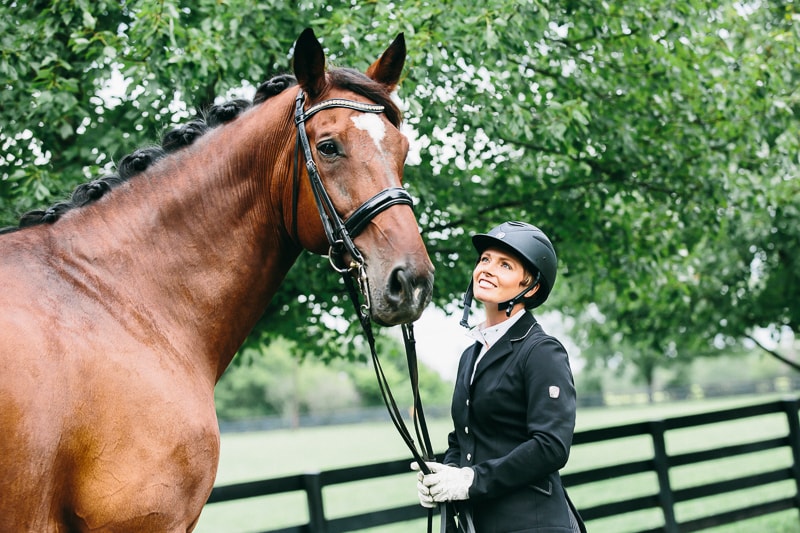
Photo Permission: Alexsandra Gills Photography
Horse and rider portraits are also a great way for newer photographers to dip their toes into the world of equine photography. Plus, portraits can be a solid source of income for established photographers.
Bonus: More riders are willing to spend money on photos of themselves or their family with a horse than a horse alone.
Portraits (Horse Only)
If you dream of taking stunning black background (or nature background) portraits, you’ll find a lot of joy in horse-only portrait photography.
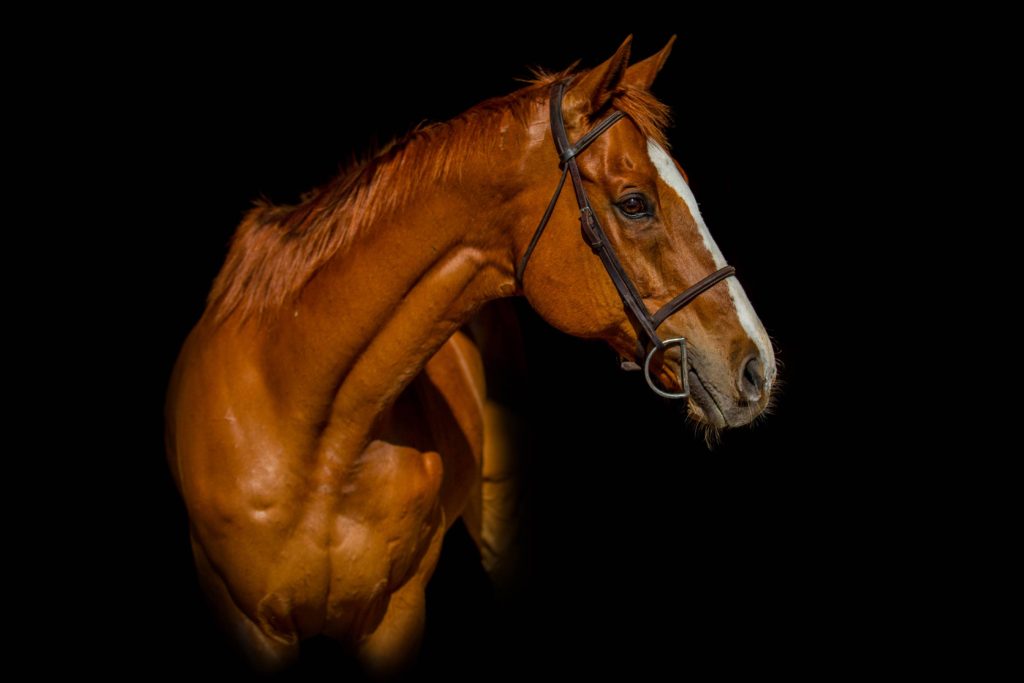
Photo Permission: Alexsandra Gills Photography
Horse-only portraits are a great addition to horse-and-rider or sales photo shoots. Otherwise, your client pool for horse-only pictures may become too small.
There’s also a budding market for holiday “mini photo shoots” these days!
Make a wreath to hang around horses’ necks and schedule a bunch of Christmas photos!
Or, consider offering some cute pregnancy sessions for expecting mares :).
Action (Events, Shows, Vacations)
There’s a wide range of action-related photography events, but the defining feature is these images capture horses (and often riders) at work or play together.
Among action photography, riding competitions are most common.
Equine show photography is challenging, but it can also be a lot of fun.
The hours are long and grueling, and you’re exposed to all sorts of weather conditions. At the end of the day, though, you’ll have some EPIC photos.
(Just be sure to wear comfortable boots and watch where you’re walking!)
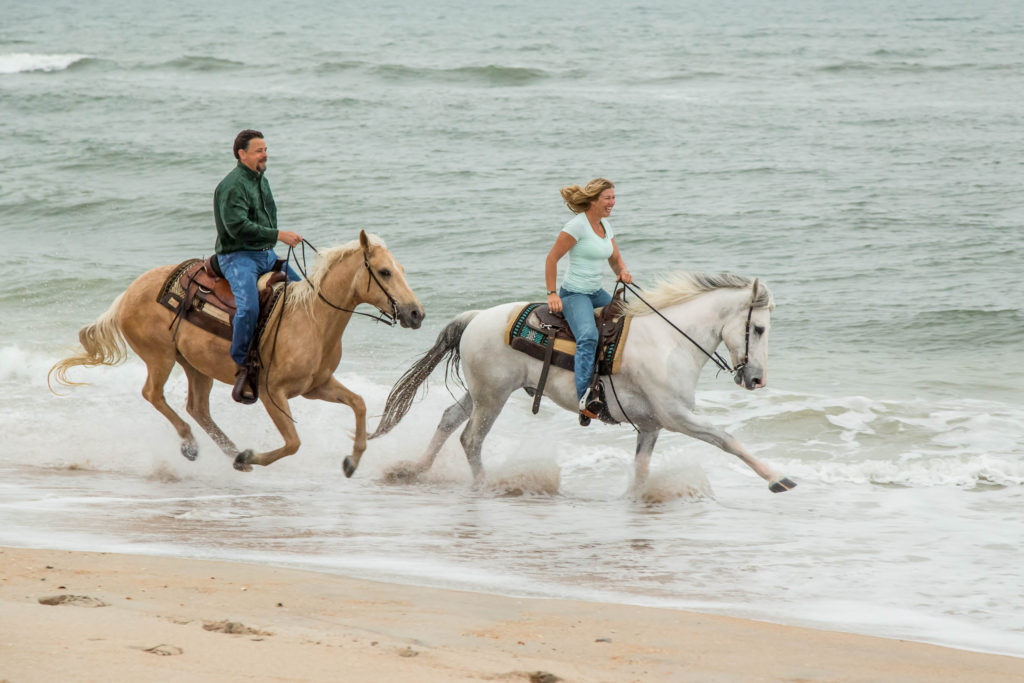
Photo Permission: Alexsandra Gills Photography
Pro Tip: Hire a second photographer to help you if there is more than one arena or class going at the same time. Otherwise, you’ll be leaving a lot of people out.
Also, many people don’t want to buy another version of the same-old, same-old photo they got at the last 10 shows they attended. Taking pictures of the champions or kids at their first shows may be a better use of your time than general photos.
You can also consider marketing yourself to individual riders or organizations that pre-pay for photos. Just be sure to contact the show organizers beforehand to make sure there are no photographers already working the event.
Promotional (Sale, Stud)
Everyone who deals with buying and selling horses, or even simply adopting them out, knows that a quality picture can attract the attention you want.
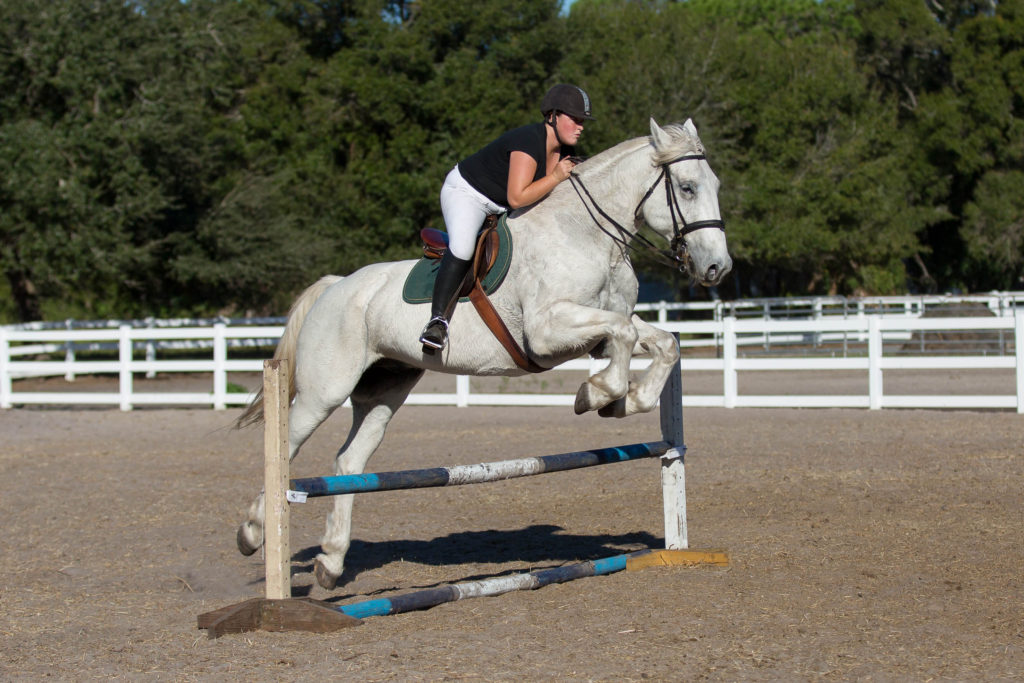
Photo Permission: Alexsandra Gills Photography
Professional sales or stud photos can accentuate a horse’s best qualities, while a poor picture can make even a gorgeous animal appear less attractive.
Pro Tip: Promotional photos are often breed specific, so make sure to familiarize yourself with the types of pictures expected.
Fine Art (Close-Ups, Wild Horses, Rare Breeds)
This category is more challenging from a financial standpoint, but it can be a great palate cleanser after dealing with some frustrating clients or getting into a creative rut.
A trip out west to photograph wild mustangs can be enchanting, but not many people are going to buy those pictures.
Over time, though, fine art photography can produce passive income if you sell them on a site like Shutterstock or iStock. Don’t rule it out!
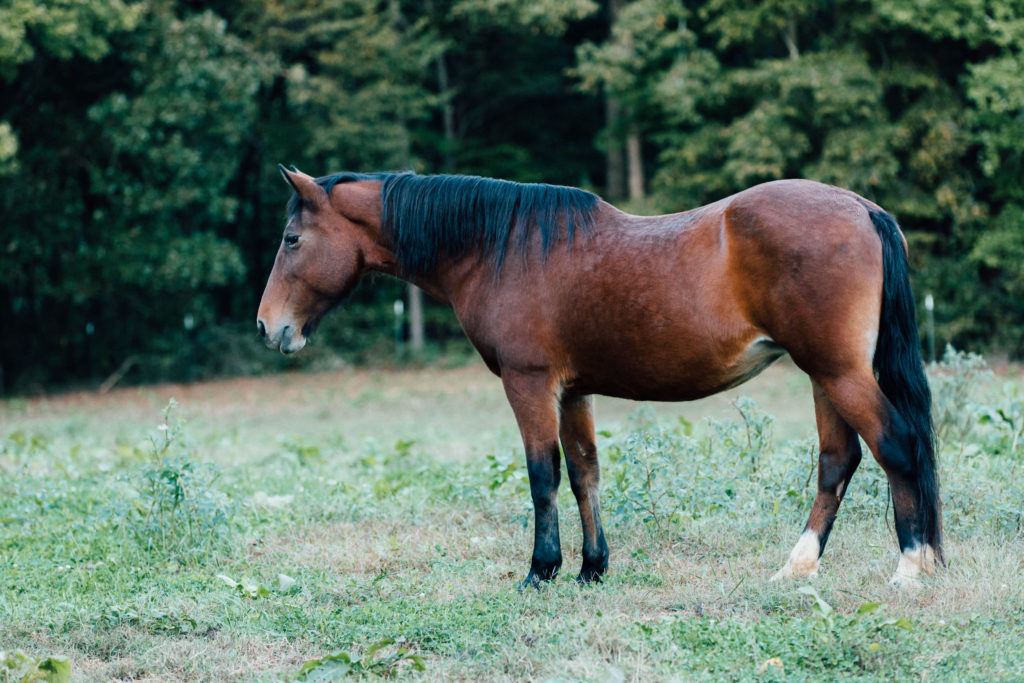
Photo Permission: Alexsandra Gills Photography
Goodbye Session (Last Ride)
Sessions that capture a horse’s final days or rides are a wonderful service you can provide for your clients.
When the end is near, many horse owners cherish some final photos by which to remember their beloved horses.
If you book these sessions, be sure you’re comfortable dealing with clients who are emotionally fragile.

Photo Permission: Alexsandra Gills Photography
Lifestyle
Lifestyle photography is basically photojournalism and has become more popular in recent years.
Take candid-style photos of a person and their horse in a way that captures their everyday relationship.
Consider capturing everything from grooming and tacking up to riding and competing.
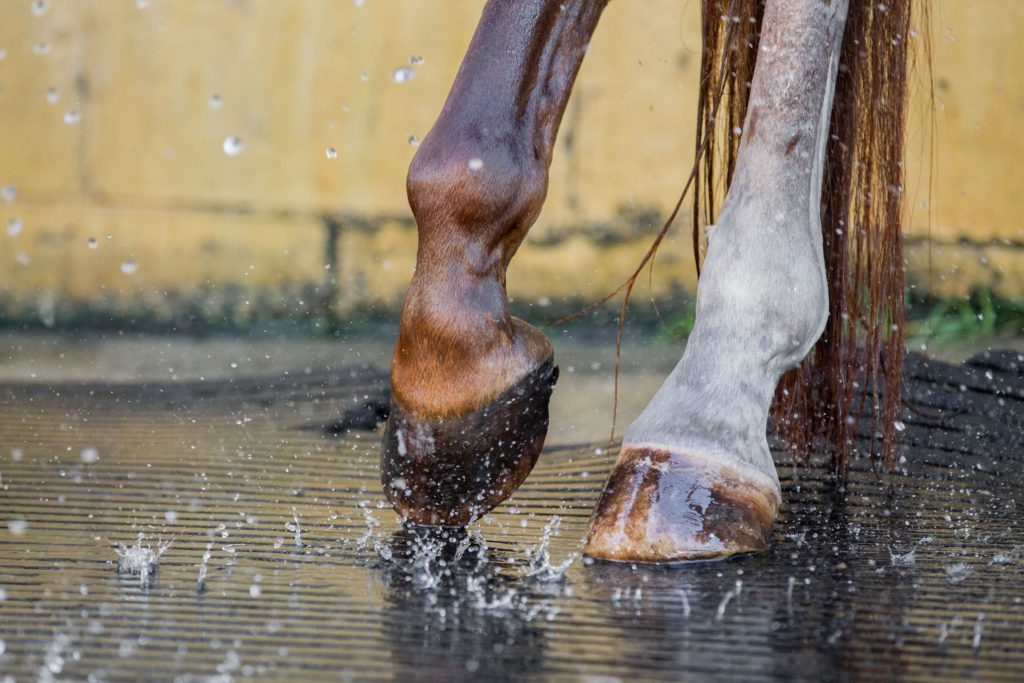
Photo Permission: Alexsandra Gills Photography
Horse Photography Equipment
If you’re new to equine photography, you’ll need some basic equipment.
First things first, you’ll need these items at minimum:
- Digital SLR camera body (The Canon EOS 5D Mark IV is our top pick.)
- Compatible lens
- Lens filter
- Memory cards
- Batteries
- Chargers
Pro Tip: You need a lens filter. I’m serious. Buy a filter as soon as you buy your lens, and put it on as soon as you take it out of the box. You’ll thank me later!
As you learn how to use your camera better, and decide which type of photography you enjoy, you’ll need to stock up on more equipment.
Additional accessories you may need include:
- Tripod/ monopod
- Camera bag/ cases
- Flashes and other off camera lighting accessories
- A neck strap
- Rain cover and other protective equipment
- Light reflectors
- Treats, toys, and noisemakers to get those horse ears up and forward!
If you do off-camera lighting, it’s a whole other ballgame. I strongly recommend taking a course about how it works. Poorly done flash photography looks terrible, but once you know what you’re doing the results can be AMAZING.
About editing software:
Equipment isn’t the only place for your hard-earned money.
Digital photography requires editing, and the gold standards are Lightroom and Photoshop.
Lightroom is ideal for tasks like correcting lens distortion, adjusting exposure, and minor touch ups. Bigger jobs, like removing light poles, fences, or halters require Photoshop.
Preparing for an Equine Photography Shoot
As with any profession, preparation is key. With photography especially, you need to have your ducks in a row.
Here are a few tips:
- Questionnaire // Consider sending your (human) client a questionnaire to get a better idea of the horse’s personality and what the owner is looking for. This can help you plan which shots you’ll want to try and anticipate what issues might occur.
- Contract // Legal contracts are highly recommended. There are websites that offer templates if you’re not sure where to start.
- Shot List // Make a shot list so you stay on track during the session and don’t forget your must-have images. That said, don’t be afraid to be spontaneous and add new shots in the moment.
- Charge Batteries // Fully charge all your batteries, even your backups.
- Check Equipment // Format your memory cards and double-check all your equipment.
- Pack Toys & Treats // Bring treats and toys to get the horse’s attention, or load up some horse noises on your phone.
- Get Help // Bring an assistant if you can. Just make sure they’re factored into your project quote.
- Directions // Getting lost on your way to a shoot doesn’t make a good impression. Make sure you have detailed directions and a map. Check your travel times for the time you need to be there, so you’re not surprised by rush hour traffic.
- Early is On Time // Show up a bit early to walk around the property, look for good backgrounds, scope out good lighting, etc.
- Check Settings // Before you start taking pictures check your settings! Set your f-stop, ISO, and shutter speed when you arrive. If you’re shooting outdoors and light is changing, recheck your settings regularly.
Pro Tip: Take a couple test shots and actually look at them with your eyeballs. Don’t spend all afternoon taking pictures before realizing they’re all too dark or grainy or blown out when you get home.
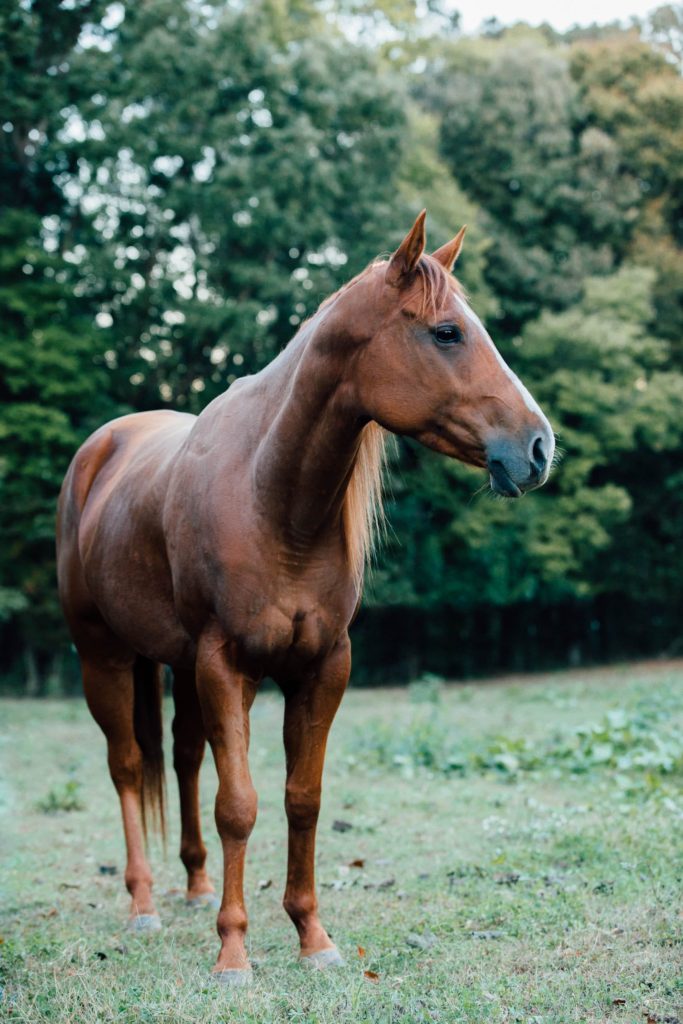
Photo Permission: Alexsandra Gills Photography
Learn about the best horse cameras for action, helmets, trailers, and more.
Horse Photography Camera Settings
Everyone wants to know what settings to use for equine photography. It’s the most common question people ask when they’re starting out!
Bad news: There is no one “right” answer.
Settings depend on your lighting situation and what exactly you’re trying to capture.
Pro Tip: If you’re new to digital photography, start by taking a class.
Learn what aperture, ISO, focal length, and shutter speed do to your pictures. If you want to be a true professional, don’t count on your camera to pick the best settings.
Cameras aren’t sentient beings and don’t know what you’re looking at.
If your camera decides the focus should be on that large rock rather than the cute pony, your end result won’t be very good!
You should also review how to use your camera’s focus points so you can follow the “rule of thirds” without having to crop half your picture off.
Pick up your camera manual and learn what all the buttons do!
For now, we’ll give you some basic settings advice for various types of images.
Camera Settings // Horse Portraits
If you’re taking a lovely portrait of a horse, you can likely start with:
- Aperture between 3.5 and 5
- Lowest possible ISO
- Quickest shutter speed (that you can get away with)
You can open up the aperture more if needed, but keep in mind horses need more depth of field than humans. Find a good depth of field mobile app, and use it until settings become second nature.
Lenses that are all the way open can result in pictures that are a bit “off.”
The key to portraits is bringing focus to the face(s) with a blurred background.
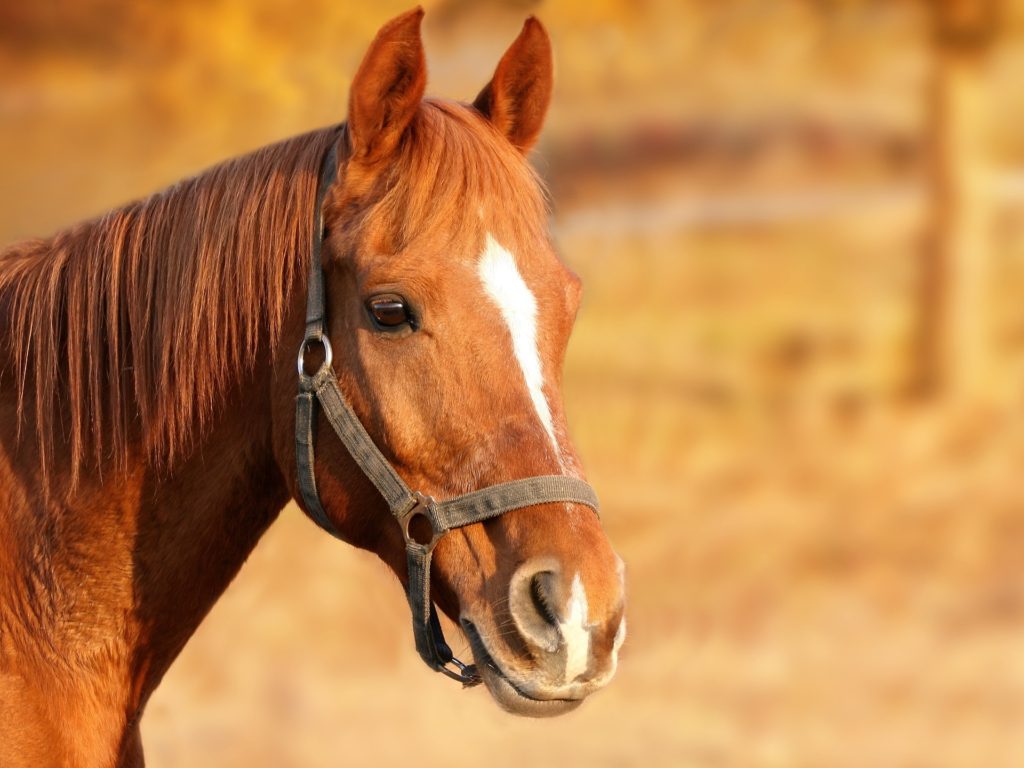
Focus on the horse and blur the background (Pixabay)
You’ll hear photographers mention “bokeh” which is “the way the lens renders out-of-focus light.” This is an absolute must in high quality photos and is the difference between a snapshot and a real portrait.
You’ll get better bokeh with a lower aperture.
Focal lengths can change the perspective of your subject – a longer focal length is more flattering, while a shorter one may distort the horse’s proportions.
When working with clients, it can be a good idea to mentioned how well they’re doing and how great the pictures are turning out. If you capture a particularly nice shot, try showing them during the session to give their ego a little boost.
If you’re doing some conformation style shots, remember that these vary based on breed. Usually you would just think of side, front, and back views to show how well built the horse is. Some breeds, however, should be shown “camped out” or at ¾ angle.
Last but not least, be quick so you get the perfect shot before the horse moves!
Camera Settings // Horse Jumping
To capture something like a horse jumping, you’ll need to practice your timing.
You want to catch the horse at the peak of the jump with their knees tucked!
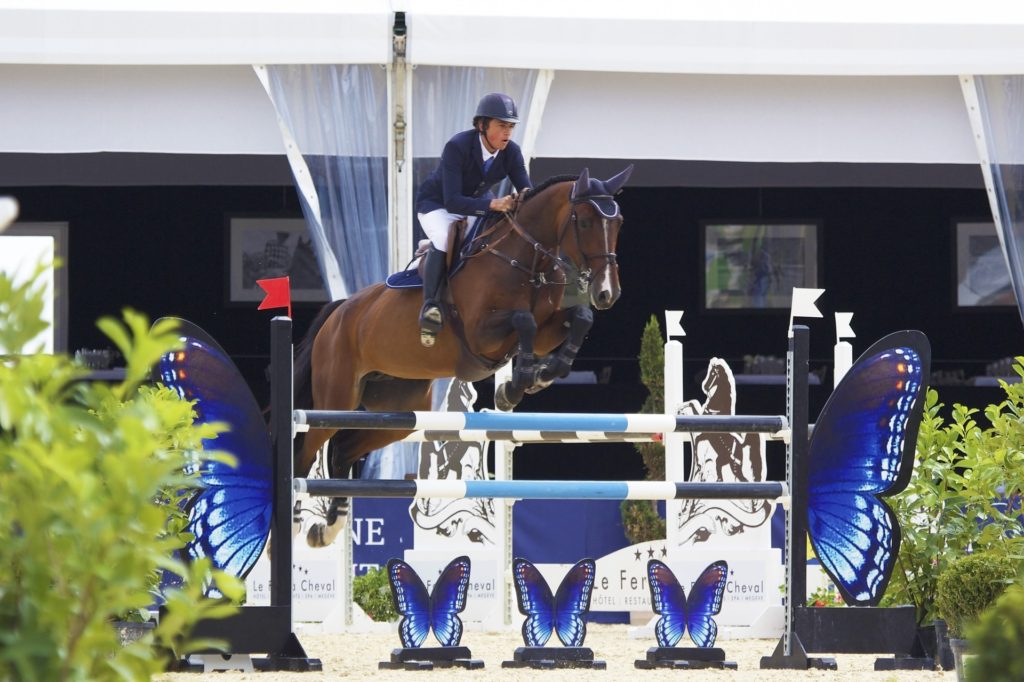
Horses are most attractive at the top of the jump (Pixabay)
You also want your shutter speed to be at LEAST 1/1000. The quicker the better to avoid blurry horses.
Use AI-Servo so your camera will track the moving object for you or focus your camera on the middle of the top rail of the jump so the horse is in focus.
Camera Settings // Horse Shows
Horse shows work a lot like jumping, meaning you need to be prepared to capture the action.
Consider these settings to start:
- Shutter speed of at least 1/1000
- Lowest ISO possible
- Large enough aperture to compensate for quick shutter and low ISO
As you play with aperture, make sure you still have enough depth of field to capture the whole horse. F/5.6 is a safe bet, but some people go down to 4 or even 2.8.
It will depend on your personal photography style and your lens/focal distance.
Pro Tip: Remember that Depth of Field app I mentioned before? It’s your friend for every kind of photography!
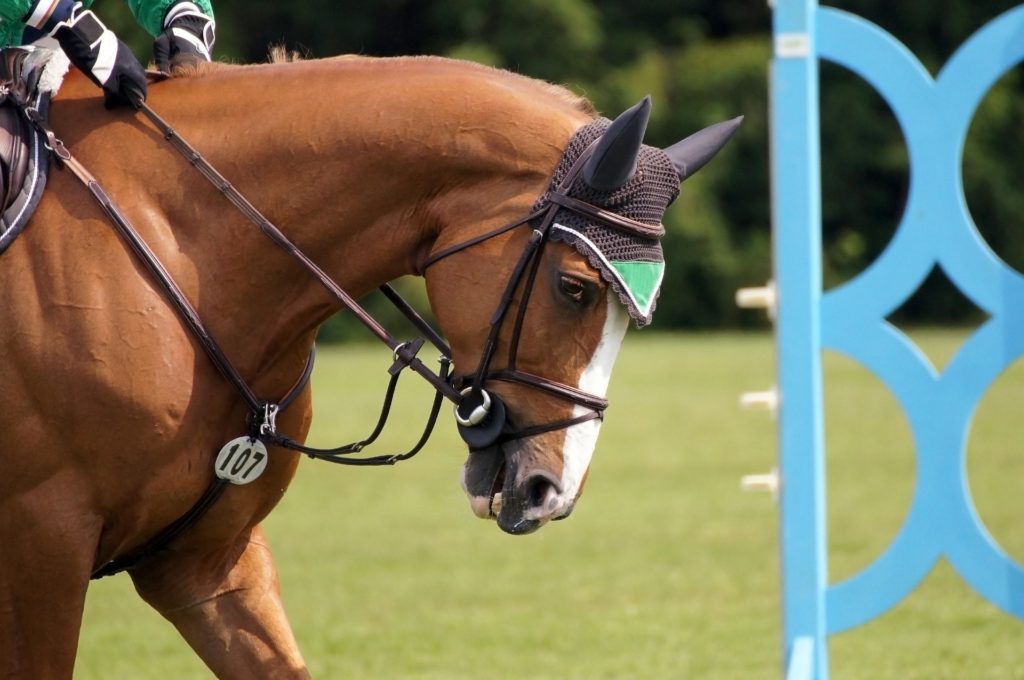
(Pixabay)
Camera Settings // Horse Racing
Much like jumping and shows — but even more so — horse racing requires the fastest shutter speed you can muster!
You probably won’t be able to get super close to the horses, so a telephoto lens would be great and can easily be rented if you’re not ready to take the plunge for your own.
Your aperture can be similar to horse shows, but it depends on your lens and the lighting conditions at the track.
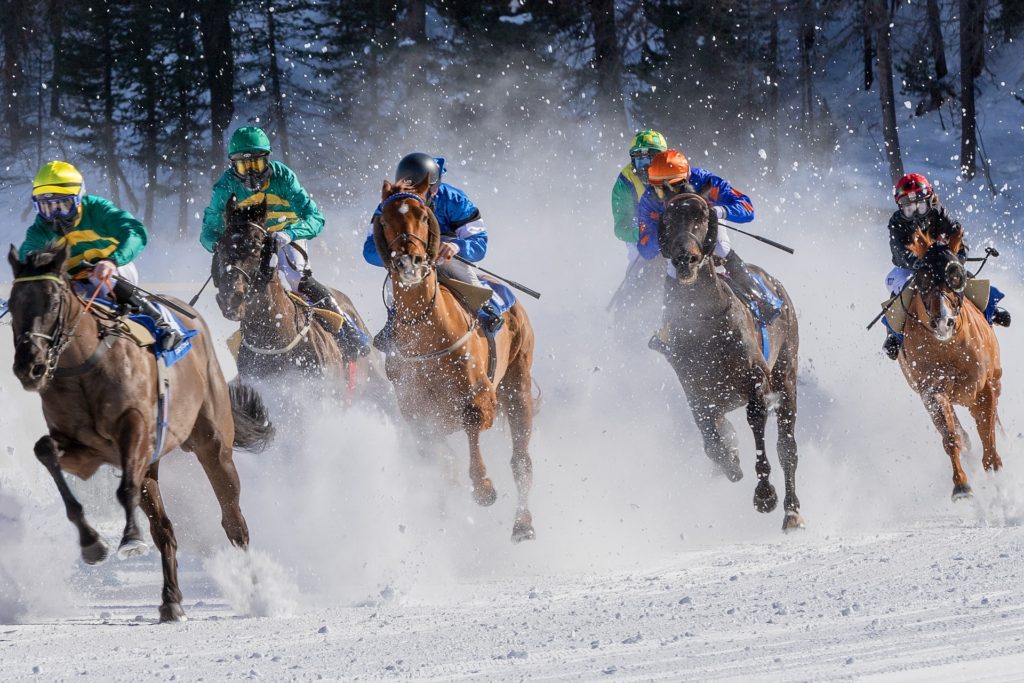
(Pixabay)
Camera Settings // Wild Horses
You’ll likely need a telephoto lens for wild horses. Oh, and a monopod or tripod because those lenses are HEAVY.
(Sure, you can try handholding it all afternoon if you want jelly arms the next day. Or if you want blurry pictures because your arms just can’t hold that much weight nice and steady.)
With such a long focal distance you can get some nice, artsy pictures with a higher f-stop.
If you want to capture the whole landscape, you can even close it up to f/7.1 to f/13. But you probably won’t want to go past f/16.
As you tighten the aperture, you’ll need to slow down your shutter speed and perhaps start raising your ISO to make up for the loss of light.

(Pixabay)
Horse Photography Safety Tips
Horses can be dangerous, so equine photography can be somewhat dangerous.
Besides the panic you’ll feel if you drop your camera on concrete, you need to pay close attention to where you are and where your horsey clients are at all times.
Stepping in holes or getting in the way of a spooked horse are also possible issues.
Sometimes camera equipment is scary to horses, so take things slowly.
Be prepared for a major freak-out and know when you need to back off. Don’t expect to be able to run toward a horse with your flash flashing and reflectors flapping in the breeze!
Keep calm — and buy insurance.

Photo Permission: Alexsandra Gills Photography
How to Edit Horse Photography
At minimum, you’ll need to do some lens correction.
Lightroom has a built-in feature where it can detect (most) lenses and fix distortion, vignetting, and chromatic aberration.
You may also need to crop your image, adjust white balance, and touch up blemishes.
Removing halters can be a challenge, and many photographers are switching to special “photography” halters that are easier to edit out.
A program like Lightroom is pretty much required these days, and Photoshop is needed for any of the bigger editing jobs.
Pro Tip: Lightroom also allows you to purchase or make presets so you can quickly edit photos to all have a similar style.
Here is a before/after example of photo editing:
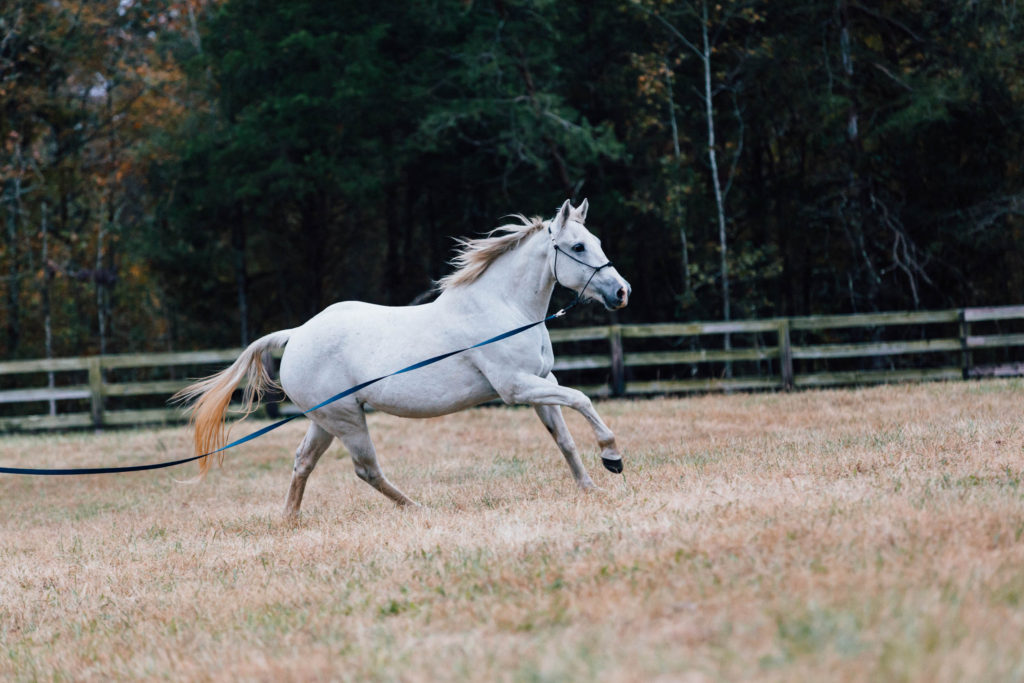
Photo Permission: Alexsandra Gills Photography
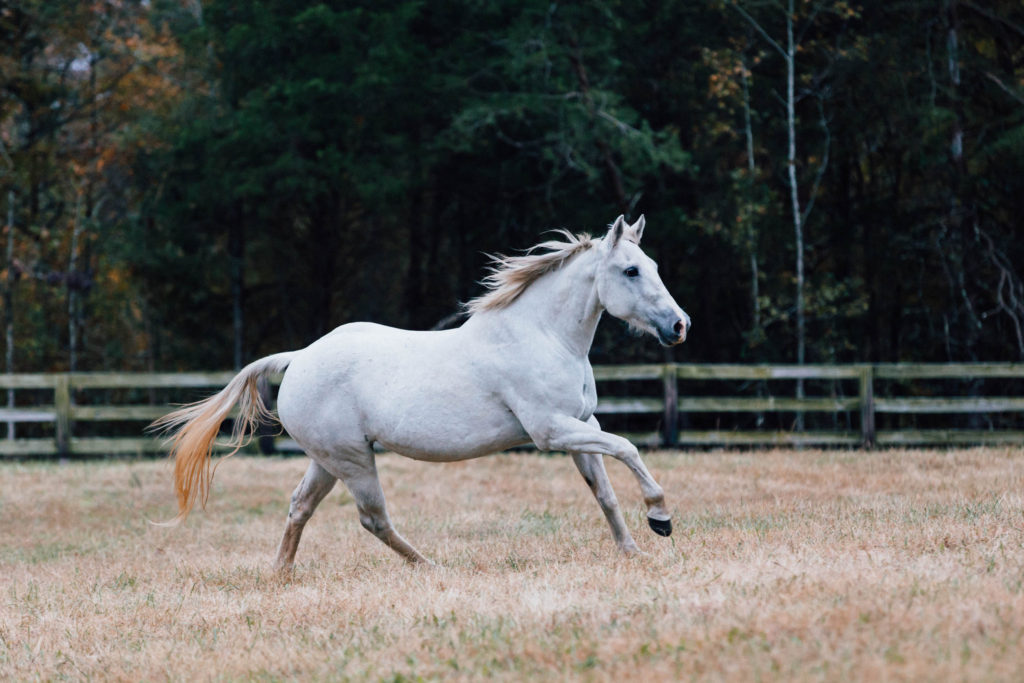
Photo Permission: Alexsandra Gills Photography
Common Challenges
Some of the biggest challenges photographers have to deal with are poor lighting, uncooperative horses, cluttered backgrounds, and capturing the horse at the correct point in its stride.
Uncooperative Horses
If you’re dealing with a grumpy horse that refuses to prick up his ears, there are a few tricks you can try!
The classic is crinkling peppermint wrappers, shaking a bag of treats, or shaking a dish of grain. Just be careful not to tease or frustrate the horse!
Photographers also use squeaky toys to get their attention, and there are a few smart phone apps that can play different sounds. If you chose to try a recording of a horse neigh, use caution so it doesn’t get your subject too worked up.
If all else fails, whip out Photoshop to fix an errant ear by swapping it out with a better one from a different photo you took!

Don’t be afraid to swap ears with Photoshop! Photo Permission: Alexsandra Gills Photography
- “Naughty” horses can also really change what sort of images you can get. The horse’s owner/handler is responsible for having their horse trained, but some personalities may simply clash with photo sessions.
- Anxious horses will have trouble standing still for long, so it’s best to try and get the most difficult photos done first.
- Hungry horses won’t be pleased with a long photo session, so owners should make sure their ponies have a full, happy tummies.
Do your best to work with the horse’s personality and quirks, but if they are absolutely not cooperating, it might be time to call it quits and give the owner a chance to reschedule.
Cluttered Farm
If you arrive at someone’s farm and the whole property is covered in random piles of clutter, you may really struggle to find a good shot.
Take a walk around and look for certain angles where you can sneak a portrait and drop out some of the undesirable distractions.
With practice and a good eye, people won’t even recognize the setting!
You can also request that your client clear out aisleways in barns or have other objects moved for shooting day.

(Pixabay)
If you or your client has a brightly colored vehicle, be sure to move it somewhere where it will remain hidden. If you don’t it WILL find its way into your pictures and it will be right in the background of the best image and too obnoxious to be edited out.
#beentheredonethat
Poor Lighting
Poor lighting can mean lots of different things. Too dark, too light, and incorrect light angle can all really put a damper on your photo session.
As the ambient light gets lower, you’ll need to adjust your ISO. The higher you go to compensate, though, the grainier your photos will look.
You can slow down the shutter speed and open the aperture up more to compensate.
Keep in mind that the slower the shutter speed the more motion blur you’ll get, which is a deal breaker for many shots.
As you open up the aperture to let more light in, your depth of field will drop. Most lenses do not handle being all the way open that well. Another big reason you shouldn’t shoot wide open is all of the aberrations you end up with. Most lenses really don’t like to be pushed to their limits and it harms your end result.
Nothing like dropping your 2.8f lens to 2.8 and ending up with one of the horse’s eyes being in focus while the rest of her face is blurry. Yikes!
Some problems can be fixed in Lightroom, but oftentimes your photo just won’t be as crisp. No bueno!

A lot of adjustments can be made in Lightroom. Photo Permission: Alexsandra Gills Photography
Okay, so what can you do if you can’t open the aperture more, can’t slow the shutter speed, and can’t raise the ISO?
You guessed it… artificial lighting!
You can use on- or off- camera flashes to light up your subject, but keep in mind that some horses are startled by the lights or equipment.
Usually show photographers have to avoid using flash because you don’t know how the horses will react during a competition.
Artificial lighting is a complex topic, but using it is an invaluable skill to have.
Do yourself a favor and take a class. Actually, you’ll probably need multiple classes.
What if it’s too bright? If you try and take some lovely, airy photos in the middle of summer at high noon, you’ll end up with clipped whites and lots of dark shadows everywhere.
Asking a person to look into sunlight just ends in tears and squints. On the other hand, shade can make their eyes disappear in the darkness.
The answer: don’t shoot at noon. Practice telling your clients no if they request that time.
Another fun term you’ll often hear is “golden hour.” This occurs shortly after sunrise or shortly before sunset and is when the light outside is more reddish and softer.
Pictures taken during the golden hour are warm and lack the harsh shadows you’d get earlier in the day.
Action Shots
Now, let’s say you want to take some pictures of horses in motion. Maybe someone hired you to take pictures of their Percheron yearlings for sale, or someone wants a good picture of the Western Pleasure horse jogging around the arena.
How in the world do you take a GOOD picture of such different action?
Different breeds or disciplines value different pictures. That Western Pleasure horse owner wants to see their trot at the point where the opposite hind and opposite fore are both juuuuust touching the ground, while the Percheron owner wants to see his babies showing off their high knee action.
Know your target audience before snapping the pictures, otherwise clients may be disappointed by what you deliver.
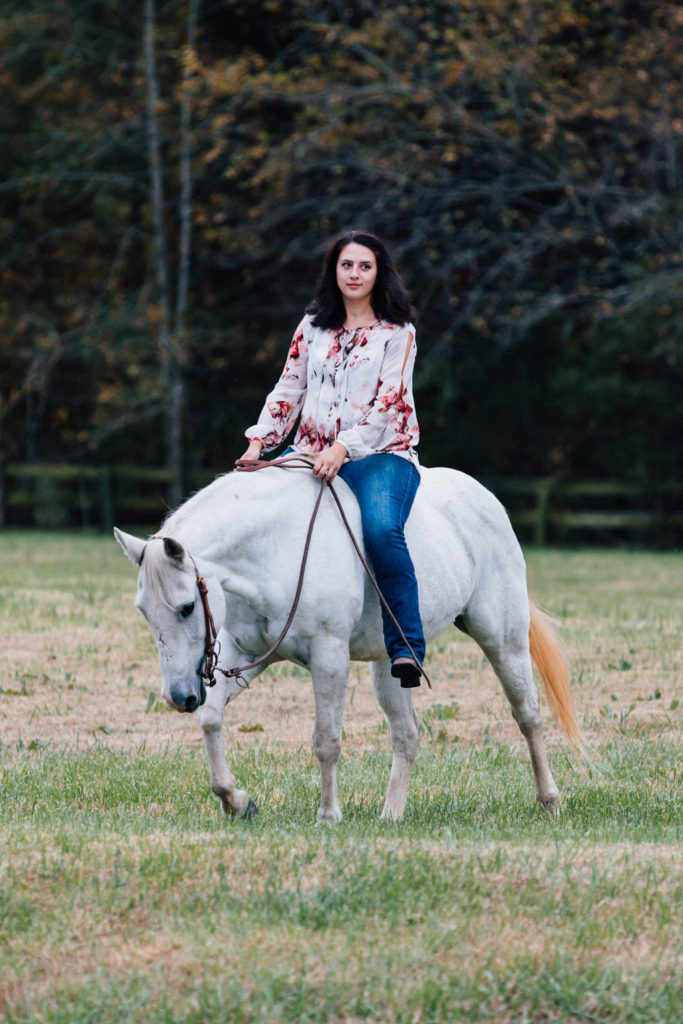
Photo Permission: Alexsandra Gills Photography
Once you know what you’re aiming for, you should be able to time when you press the shutter to catch that exact perfect moment.
Depending out your shutter speed and camera’s speed (how fast it can take multiple pictures and how fast it can write these pictures to the card) you can do a quick burst around the right point and then choose the best one later.
Equine Photography Prices
How do you know how much to charge for your photo session? This will depend on your target audience and your skill level.
Your best bet is to take a look at what other successful photographers in your area charge, be realistic about how much of your time is actually spent working on each session, and take into account how much you’re paying for insurance, a website, your car, classes, equipment, and assistant, marketing and anything else directly related to your photography business.
If you undercharge people it can devalue your work, but if you overcharge people you can struggle to get your business off the ground.
Consider taking a class or attending a workshop that discusses the business aspect of photography — not just camera settings!
Frequently Asked Questions
Q: What’s the best camera for horse photography?
The best camera is the best one you can afford. If you’re a Canon lover consider the Canon EOS 5D Mark IV and if you prefer Nikon take a look at the Nikon D5.
Read about even more of the best horse cameras for your helmet, barn, trailer, action, and more.
Q: What’s the best lens for horse photography?
Your best overall lens for horse photography is a 70-200 f 2.8. These are pricey, but well worth the money.
Q: What’s the best Canon lens for horse photography?
The Canon EF 70-200mm f/2.8L is III USM lens is your top choice.
Q: What’s the best Canon camera for horse photography?
The Canon EOS 5D Mark IV Full Frame Digital SLR Camera Body is your best option.
Q: What’s the best Nikon lens for horse photography?
The Nikon 70-200mm f/2.8G ED VR II AF-S Nikkor Zoom Lens is great for equine photography.
Q: How much do horse photographers make?
Equine photography can be a difficult field. With fewer people printing off pictures and more people having cameras in their pockets at all times (i.e. phones), it can be hard to make the money you need to cover your time.
Many new photographers forget to include the time it takes to edit and end up making less than minimum wage. You also need to factor in insurance and travel costs!
Q: How do you get into horse photography?
Start by taking pictures of horses — lots of them!
It’s strongly recommended to take classes and attend workshops and conferences, because the amount you learn in just a few short days could take years to figure out on your own.
Q: Why photograph your horse?
There are a few great reasons to photograph your horse. Of course, taking pictures is a great way to have a keepsake of your horse, something you can look back at and remember him by.
Taking photos also helps with selling your horse, particularly if you use a professional who knows how to make your horse look his best. It’s also helpful to see what he looks like in a picture, to get a different perspective on his proportions and muscling.
You can also use photographs to track weight loss or gain—it can be tough to see change when you look at your horse every day!
The best kind of horse photograph is one with the two of you together, whether it’s to remember a fun ride or a great finish at a horse show.
Q: How should horses pose for pictures?
Initially, remember that some horses might look better from different angles or while doing different things (some horses look better in motion, others look fantastic posed for a traditional sale shot).
Have your horse stand on level ground and get him to stand as square as possible. Then, arrange the foreleg nearest the camera a bit forward, and the same hind leg a bit back.
Find something that will catch his interest (like a treat wrapper or a
Ready, Set, Shoot!
Horse photography is an amazing, magical, wonderful career that many people enjoy. Despite current technology, it’s still an art and takes a lot of education and practice to truly master.
With enough dedication, patience, money, and a little luck, you’ll be off and running!
P.S. Enjoy this article? Trot on over to:
- Best Horse Cameras (Action, Helmet, Trailer, Drone, Barn)
- 7 Tips to Prepare Your Horse for a Perfect Photo Shoot
- 5 Soloshot Alternatives to Record Your Ride Inside & Out
- You’re Hired! How to Be a Star Working Student Equestrian
- 12 Gifts Barn Owners, Managers & Workers Will Actually Love
- I Want a Horse But Can’t Afford One. Now What?

